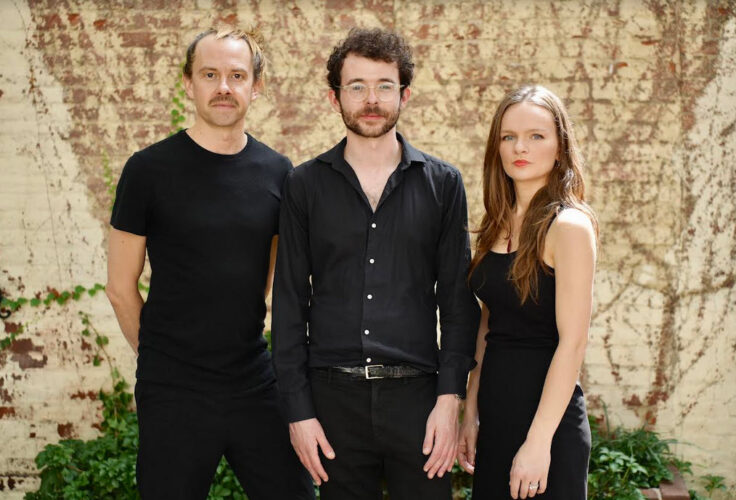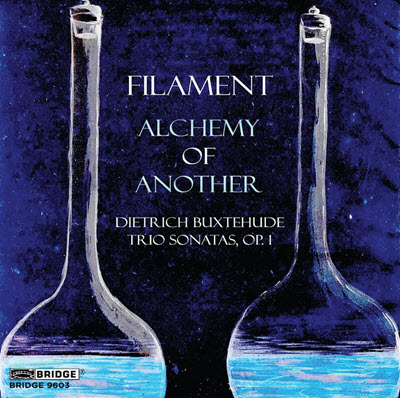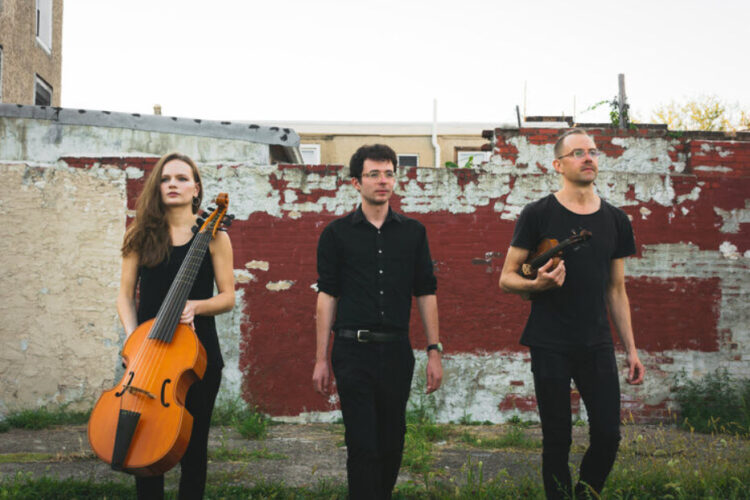by Anne E. Johnson
Published June 8, 2024
Filament: Alchemy of Another. Buxtehude Trio Sonatas, Op. 1. Bridge Records 9603

When the Philadelphia-based Baroque trio Filament formed in 2019, some of the first music they played was by Dietrich Buxtehude. It seems appropriate, then, that their debut album, Alchemy of Another, revisits the composer.
The seven Op. 1 sonatas, published in 1694, represent the first half of Buxtehude’s output in the genre (the other seven comprise Op. 2, from 1698). They exhibit his impressive contrapuntal skill as well as his awareness of advances in crafting instrumental movements beyond the strictures of dance-types and fantasias. (Filament were part of EMA’s virtual 2021 Emerging Artists Showcase with Buxtehude, naturally, on their program.)

Filament chose not to program the Op. 1 sonatas in numerical order. As published, the respective tonics form a molle hexachord plus one added step, resulting in a series of keys that move stepwise up from F to E. Instead, the ensemble presents a pleasant mixture of keys and modes. It’s a nicely considered detail, although arguably unnecessary in this day when listeners rarely consume an entire album at one sitting.
The choice to open with Sonata No. 3 in A minor was inspired: Its aching Adagio first movement creates an otherworldly atmosphere. Typical of its time, the sonata has many short, contrasting movements. After the introduction, a spritely Allegro is followed by a few chordal bars of Lento and then the complex contrapuntal dialogue of a Vivace, and through a few more tempos, finally landing on a dense, chromatic slow movement. Every twist and turn of the musical route is carefully thought out and executed in this performance.
The journey through each piece is a little adventure. There’s no way to predict how many movements any given sonata will have or recognize when a change in tempo or style constitutes its own movement or just a segue within a larger idea. Filament captures every nuance of the many changes, particularly in the minor-key sonatas that give Buxtehude a chance to play with the stylus phantasticus.
From the weird to the conventional, these sonatas run the stylistic gamut. The C-major Op. 1, No. 5 has a rhythmic and harmonic stability that’s almost galant, yet Filament never lets it become trite. The dotted rhythm and oscillating eighth notes of the fifth-movement Allegro gigue are especially vibrant, contrasting pleasingly with the chromatics of the following Adagio; Filament makes the unusual and amusing decision to increase the Adagio’s speed until it seamlessly morphs into the work’s finale Allegro.

Violinist Evan Few, using almost no vibrato, never lets the energy of his tone flag. His faster rhythms are precise and buoyant, while the slower movements are patient yet never staid. Few is also a skilled improviser, which he demonstrates in unpretentious, exploratory passages in preludes like the one that opens the G Major Op. 1, No. 2.
Far more than just providing a bassline, Elena Kauffman’s viola da gamba adds character and color. Buxtehude gives her plenty of chances to carry on a dialog with Few, both as responder and instigator of musical ideas, for example in the Vivace of the last sonata, in E minor (which does appear last on the track list).
As the glue for this sonic sculpture, John Walthausen’s harpsichord is true and constant. There are occasionally moments, as in the opening of Sonata No. 4 in B-flat, when he gets to introduce material. But mostly he functions as a field for the feet of melody to dance on, establishing the lay of the land and ensuring that the ground is neither too soft nor too firm.
Anne E. Johnson is a freelance writer based in New York. Her arts journalism has appeared in the New York Times, Classical Voice North America, Chicago On the Aisle, and PS Audio’s Copper Magazine. She teaches music theory and ear training at the Irish Arts Center in Manhattan. For EMA, she recently wrote about celebrating Ockeghem’s 600th.




